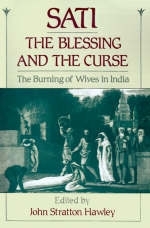
Sati, the Blessing and the Curse
The Burning of Wives in India
Seiten
1994
Oxford University Press Inc (Verlag)
978-0-19-507774-2 (ISBN)
Oxford University Press Inc (Verlag)
978-0-19-507774-2 (ISBN)
This is a collection of new essays on the phenomenon of sati (or suttee), the burning of wives in India. The contributors include both American and Indian scholars, and they address basic questions about this controversial phenomenon and the moral issues it involves.
Several years ago in Rajasthan, an eighteen-year-old woman was burned on her husband's funeral pyre and thus became sati. Before ascending the pyre, she was expected to deliver both blessings and curses: blessings to guard her family and clan for many generations, and curses to prevent anyone from thwarting her desire to die. Sati also means blessing and curse in a broader sense. To those who revere it, sati symbolizes ultimate loyalty and
self-sacrifice. It often figures near the core of a Hindu identity that feels embattled in a modern world. Yet to those who deplore it, sati is a curse, a violation of every woman's womanhood. It is murder mystified, and as
such, the symbol of precisely what Hinduism should not be. In this volume a group of leading scholars consider the many meanings of sati: in India and the West; in literature, art, and opera; in religion, psychology, economics, and politics. With contributors who are both Indian and American, this is a genuinely binational, postcolonial discussion. Contributors include Karen Brown, Paul Courtright, Vidya Dehejia, Ainslie Embree, Dorothy Figueira, Lindsey Harlan,
John Hawley, Robin Lewis, Ashis Nandy, and Veena Talwar Oldenburg.
Several years ago in Rajasthan, an eighteen-year-old woman was burned on her husband's funeral pyre and thus became sati. Before ascending the pyre, she was expected to deliver both blessings and curses: blessings to guard her family and clan for many generations, and curses to prevent anyone from thwarting her desire to die. Sati also means blessing and curse in a broader sense. To those who revere it, sati symbolizes ultimate loyalty and
self-sacrifice. It often figures near the core of a Hindu identity that feels embattled in a modern world. Yet to those who deplore it, sati is a curse, a violation of every woman's womanhood. It is murder mystified, and as
such, the symbol of precisely what Hinduism should not be. In this volume a group of leading scholars consider the many meanings of sati: in India and the West; in literature, art, and opera; in religion, psychology, economics, and politics. With contributors who are both Indian and American, this is a genuinely binational, postcolonial discussion. Contributors include Karen Brown, Paul Courtright, Vidya Dehejia, Ainslie Embree, Dorothy Figueira, Lindsey Harlan,
John Hawley, Robin Lewis, Ashis Nandy, and Veena Talwar Oldenburg.
John Stratton Hawley is Professor and Chair of the Department of Religion at Barnard College, and Director of the South Asian Institute at Columbia University. He is the editor of Songs of the Saints of India (Oxford, 1988) and Fundamentalism and Gender (Oxford, 1993), as well as numerous other books on Indian religion and literature.
| Erscheint lt. Verlag | 3.11.1994 |
|---|---|
| Zusatzinfo | frontispiece, halftones, map |
| Verlagsort | New York |
| Sprache | englisch |
| Maße | 235 x 155 mm |
| Gewicht | 476 g |
| Themenwelt | Geisteswissenschaften ► Religion / Theologie ► Hinduismus |
| Sozialwissenschaften ► Soziologie ► Mikrosoziologie | |
| ISBN-10 | 0-19-507774-1 / 0195077741 |
| ISBN-13 | 978-0-19-507774-2 / 9780195077742 |
| Zustand | Neuware |
| Haben Sie eine Frage zum Produkt? |
Mehr entdecken
aus dem Bereich
aus dem Bereich
Worshipping the Eternal Mother at a North American Hindu Temple
Buch | Hardcover (2024)
Oxford University Press Inc (Verlag)
CHF 136,00


